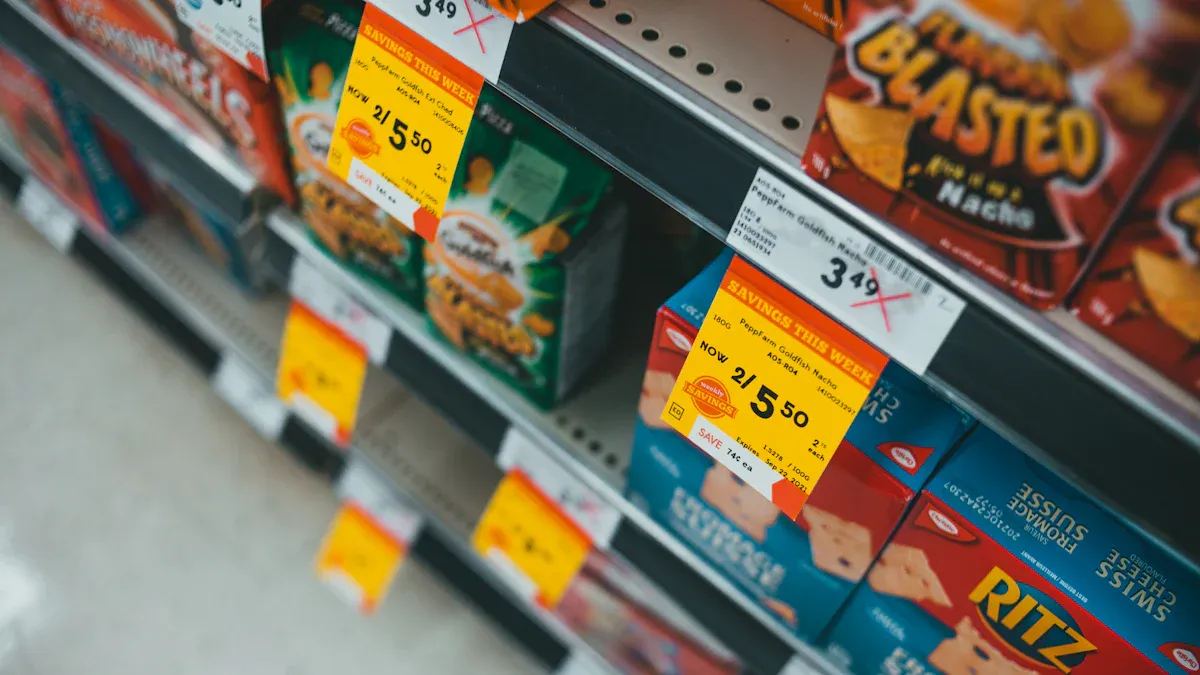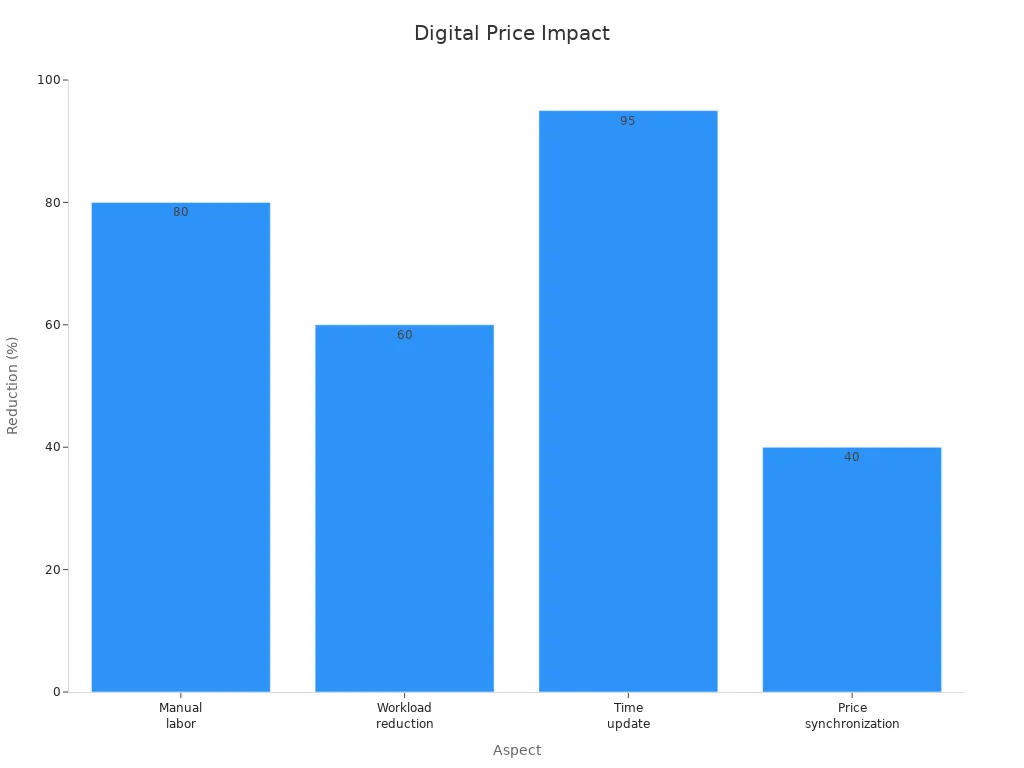
IKEA has embraced digital price tags to streamline store operations and enhance pricing accuracy. With Electronic Shelf Labels and the ESL Gateway AP, staff can update prices instantly, reducing manual labor and energy use. This sustainable shift supports Esl Retail initiatives by cutting paper waste and minimizing emissions. ESL Price Tag systems, used in IKEA stores, last for years on a single battery and help lower deforestation and resource consumption, providing a more reliable and eco-friendly shopping experience.
How Digital Price Tags Work at IKEA

What Are Digital Price Tags and Electronic Shelf Labels?
Digital price tags and electronic shelf labels represent a modern solution for retail pricing. These devices replace traditional paper tags with digital displays, allowing stores to manage prices efficiently. Digital shelf labels connect to a central system, ensuring that every price on the shelf matches the information in the store’s database.
Key Features of Electronic Shelf Labels
- Automated price updates linked to point-of-sale systems
- High-resolution e-ink or LCD displays for clear product information
- Long battery life, often lasting several years
- Multi-language support for global operations
- QR codes for additional product details or online reviews
- Dynamic pricing capabilities to adjust prices based on demand or inventory
- Integration with inventory management, showing stock levels and restock dates
These features help retailers like IKEA maintain pricing accuracy and reduce manual labor. The system also supports product location assistance and can display promotional information, improving the customer experience.
Types of Digital Price Tags Used by IKEA
IKEA uses a range of digital shelf labels, including e-ink and LCD models. Some tags display only prices, while others show product details, stock status, or QR codes. The company selects tags based on store layout and product type. Centralized control allows IKEA to manage uniform pricing and promotions across all locations.
Wireless Communication and Centralized Control
Digital price tags at IKEA rely on wireless technology for communication. The system uses Bluetooth Low Energy or similar protocols to connect each tag to a central server. This setup enables real-time updates and ensures that every label displays the correct price.
Real-Time Price Updates Across Stores
Centralized control allows IKEA to synchronize prices instantly across all stores. When the company updates a price in the system, every digital shelf label reflects the change within seconds. This process eliminates pricing errors and ensures customers always see accurate information.
Integration with Inventory and Pricing Systems
Digital shelf labels integrate with inventory and pricing systems. The connection allows the labels to display current stock levels and expected restock dates. Staff can also use the system to manage dynamic pricing, adjusting prices based on inventory or market trends. This integration streamlines operations and reduces the risk of human error.
IKEA’s Implementation of Digital Price Tags
Rollout in IKEA Stores Worldwide
IKEA has introduced digital price tags in stores worldwide. The rollout follows a phased approach, starting with high-traffic locations. The company evaluates each store’s needs and installs the appropriate digital shelf labels to maximize efficiency.
Staff Training and Adaptation to New Technology
IKEA invests in staff training to ensure smooth adoption of digital price tags. Employees learn to operate the system, update prices, and troubleshoot common issues. This training helps staff focus more on customer service and less on manual price changes.
Efficiency Improvements from Digital Price Tags at IKEA

Faster and More Accurate Price Updates
Real-Time Synchronization of Prices
IKEA’s digital transformation has enabled real-time synchronization of prices across all store locations. When the central system updates a price, digital shelf labels display the new pricing within seconds. This rapid update process ensures that customers always see the correct price on the shelf, which reduces confusion and builds trust. The ability to synchronize prices instantly also allows IKEA to respond quickly to market changes, promotions, or inventory shifts.
Eliminating Manual Tag Replacement
Traditional price changes required staff to print, cut, and manually replace paper tags. This process consumed hours and increased the risk of human error. With digital price tags, IKEA has eliminated the need for manual tag replacement. Staff no longer spend time searching for the correct product or risking mistakes during updates. The system automates the entire process, which leads to nearly error-free pricing and a more consistent shopping experience.
Reduced Labor and Operational Costs
Less Time Spent on Price Changes
Automating price updates with electronic shelf labels has significantly reduced the time and labor required for pricing management. The following table highlights the impact of digital price tags compared to traditional methods:
| Aspect | Digital Price Tags Impact | Traditional Price Tags Impact |
|---|---|---|
| Manual labor for price updates | Up to 80% reduction in manual labor | High manual labor required |
| Workload reduction | 60% reduction in price updates, shelf management, and order picking | Higher workload due to manual updates |
| Time to update prices | 95% reduction in time needed | Hours required for manual changes |
| Price synchronization speed | 40% faster synchronization | Slower, manual synchronization |
| Error rate | Nearly eliminates manual errors | Manual errors common |

Retailers such as Walmart and Lidl have reported similar results, confirming that digital price tags can reduce the time needed for price changes by up to 95%. Automation also leads to a 40% faster price synchronization process, which helps stores operate more efficiently.
Reallocating Staff to Customer Service Roles
By reducing the manual workload, IKEA can reassign staff to more valuable roles, such as assisting customers or managing store operations. Employees spend less time on repetitive tasks and more time providing personalized service. This shift not only improves operational efficiency but also enhances the overall customer experience.
Improved Inventory Management with Electronic Shelf Labels
Automatic Stock Level Synchronization
Electronic shelf labels integrate with inventory management systems to provide real-time updates on stock levels. This integration helps IKEA avoid stockouts and ensures that the information displayed to customers is always accurate. Automated tracking and shelf monitoring reduce shortages and lead to smoother store operations.
Note: Real-time inventory updates eliminate pricing errors and stockouts, which supports better sales and customer satisfaction.
Reducing Pricing and Inventory Errors
Digital shelf labels minimize manual errors by automating both pricing and inventory updates. The following table summarizes key improvements:
| Inventory Metric | Improvement Figures | Explanation |
|---|---|---|
| Stockouts Reduction | 30–50% decrease | Automated tracking and ESLs reduce shortages, leading to fewer lost sales and smoother operations. |
| Inventory Accuracy | 20% improvement | Real-time inventory systems with ESLs enhance accuracy by minimizing manual errors. |
| Customer Satisfaction | 18% increase | Improved inventory accuracy and availability contribute to higher customer satisfaction. |
Efficient planogram changes and data-driven insights further support consistent shelf management. Enhanced employee productivity, enabled by automation, leads to a better shopping experience for IKEA’s customers.
Benefits of Digital Price Tags for IKEA and Customers
Enhanced Customer Experience in IKEA Stores
Always Up-to-Date Pricing Information
Customers visiting IKEA stores now see accurate prices at all times. Digital shelf labels update instantly when the central system changes a price. This real-time synchronization removes confusion and ensures that shoppers never encounter outdated or incorrect pricing. Staff can focus on helping customers rather than correcting price tags, which improves the overall shopping experience.
Clearer and More Detailed Product Information
Digital shelf labels display more than just the price. They can show product details, stock status, and even QR codes that link to online reviews or assembly instructions. Shoppers benefit from clear, easy-to-read displays that provide essential information at a glance. This transparency helps customers make informed decisions and reduces the need for staff intervention.
Environmental Impact of Electronic Shelf Labels
Reduction in Paper and Printing Waste
Switching to digital shelf labels allows IKEA to eliminate the need for paper price tags. This change leads to significant reductions in paper and printing waste. The following table highlights the environmental benefits observed by other companies that adopted similar technology:
| Company | Paper Reduction | Environmental Impact |
|---|---|---|
| Barclays Capital | 48.1% reduction; 20 million sheets saved | 567 tonnes CO2 saved; 2340 trees preserved |
| Littlewoods | Over 50,000 tonnes paper saved | 315,000 tonnes CO2 reduction; 1.3 million trees saved |
Digital shelf labels use reusable materials and ultra-low power e-ink displays. They only consume energy during updates, which further reduces environmental impact. By removing the need for printing and transporting paper labels, IKEA supports lower carbon emissions and helps preserve natural resources.
Lower Carbon Footprint for IKEA
Electronic shelf labels contribute to a lower carbon footprint for IKEA. Research shows that digital labels reduce emissions by cutting down on printing, transportation, and labor. The technology supports corporate sustainability goals by reducing logging and deforestation. Digital shelf labels also help supermarkets lower food waste by enabling quick price changes for items nearing expiration, which further decreases emissions.
Long-Term Cost Savings for IKEA
Decreased Material and Printing Costs
IKEA saves money by eliminating recurring expenses for paper, ink, and printing equipment. Digital price tags last for years and require minimal maintenance. Retailers with frequent price changes benefit most, as they avoid the high costs of manual updates and material waste.
Return on Investment from Digital Price Tags
Investing in digital shelf labels provides a strong return on investment. A typical retailer with 10,000 price tags can save up to $54,000 annually by reducing labor, energy, and pricing errors. The payback period for the system often falls between 12 and 24 months. Over five years, digital shelf labels offer a lower total cost of ownership compared to traditional methods. Key metrics include labor cost reduction, improved pricing accuracy, and increased sales during promotions.
Tip: Digital shelf labels not only improve efficiency but also support sustainability and profitability for retailers like IKEA.
Addressing Challenges and Concerns with Digital Price Tags
Technical Issues and System Reliability
Managing System Downtime and Maintenance
Retailers face several technical risks when deploying digital price tags. Network interference can cause missed or delayed updates. Hardware failures may result in blank or incorrect displays. Software bugs sometimes lead to system crashes. Power outages can cause total downtime. The table below summarizes these risks and common mitigation strategies:
| Risk Factor | Potential Impact | Mitigation Strategy |
|---|---|---|
| Network Interference | Missed or delayed price updates | Upgrade wireless infrastructure |
| Hardware Failure | Blank or incorrect displays | Keep spare units for quick swap |
| Software Bugs | System crashes or errors | Schedule regular software updates |
| Power Outages | Total system downtime | Use backup power supplies |
Retailers monitor system performance using metrics such as uptime, update accuracy, and battery health. Regular audits and analytics help identify operational gaps. Maintenance includes battery replacement for e-paper displays and quick swaps for faulty units. Backup procedures and disaster recovery plans support system stability.
Note: Publicly available reports focus on setup time, training, and cost-benefit analysis rather than technical failure rates or detailed maintenance statistics.
Ensuring Data Security and Privacy
Digital price tag systems connect to central servers and store sensitive pricing data. Retailers must protect this information from unauthorized access. Regular software updates, encrypted communication, and strict access controls help safeguard data. Vendor support contracts often include security patches and monitoring services. These measures reduce the risk of data breaches and maintain customer trust.
Dynamic Pricing and Customer Perceptions
Transparency in Price Changes
Dynamic pricing allows retailers to adjust prices quickly in response to demand or inventory. Research shows that consumers value transparency in these changes. When retailers explain price adjustments clearly, customers report higher trust and are more likely to return. Opaque or unexplained price shifts can trigger negative reactions and reduce loyalty. Fairness and openness remain essential for customer acceptance.
Communicating Pricing Updates to Shoppers
Electronic shelf labels make it easy for shoppers to see current prices. Studies indicate that consumers find digital price tags helpful and easy to use. These labels improve the store’s image and help customers identify product prices. However, consumers may not always perceive dynamic pricing as fair. Retailers can address this by providing clear explanations for price changes and involving customers in the process when possible.
Tip: Transparency and communication help build trust and support long-term customer relationships in a digital pricing environment.
Initial Investment and Organizational Change at IKEA
Upfront Costs and Budget Considerations
Implementing digital price tags requires significant upfront investment. Costs include purchasing hardware, installing wireless infrastructure, and training staff. While these expenses can be high, many retailers find that long-term savings in labor and materials offset the initial outlay. Careful budgeting and phased rollouts help manage financial impact.
Managing Change Among Staff and Customers
Transitioning to digital price tags involves organizational change. Staff need training to operate new systems and troubleshoot issues. Some employees may feel uncertain about new technology. Ongoing support and clear communication ease the transition. Customers also need time to adapt to digital displays. Retailers can help by providing guidance and ensuring that digital labels remain clear and accurate.
Change management strategies, including staff training and customer education, play a key role in successful adoption.
IKEA’s Approach to Managing Electronic Shelf Labels
Ongoing Support and Maintenance for Digital Price Tags
Dedicated IT and Support Teams
IKEA relies on dedicated IT and support teams to ensure the smooth operation of its digital price tag system. These teams monitor the network infrastructure, troubleshoot technical issues, and provide rapid response when problems arise. They also handle battery replacements and hardware swaps, minimizing downtime for electronic shelf labels. By assigning clear responsibilities, the company maintains high system reliability and consistent pricing accuracy across all stores.
Support teams work closely with store staff to resolve issues quickly. They use diagnostic tools to identify faults and implement solutions before disruptions affect customers. This proactive approach helps maintain a seamless shopping experience and supports the company’s commitment to operational excellence.
Regular System Updates and Improvements
Regular system updates keep the digital price tag platform secure and efficient. IT teams schedule software upgrades to introduce new features, enhance security, and fix bugs. These updates often occur during off-peak hours to avoid disrupting store operations. The company also reviews hardware performance, replacing outdated components as needed.
Continuous monitoring allows the teams to identify trends and anticipate future needs. By staying current with technology, IKEA ensures that its electronic shelf labels remain reliable and effective for both staff and shoppers.
Continuous Improvement Based on Feedback
Gathering Input from Staff and Customers
IKEA values feedback from both staff and customers to drive ongoing improvements. The company uses several methods to collect insights:
- Net Promoter Score (NPS), Customer Satisfaction Score (CSAT), and Customer Effort Score (CES) measure customer satisfaction and experience.
- Suggestion systems, surveys, and forums allow frontline employees to share ideas and report challenges.
- Data analysis and visualization tools convert raw feedback into actionable insights, guiding decision-making and prioritization.
This structured approach ensures that feedback from all stakeholders informs the evolution of the digital price tag system.
Adapting Digital Price Tag Solutions to Evolving Needs
The company adopts a test-and-learn culture to refine its digital price tag solutions. Teams use A/B testing and prototyping to validate new features and strategies. Iterative development helps the organization respond to real-world feedback and changing requirements.
- Startups and large retailers alike use customer surveys, reviews, and direct interactions to identify pain points.
- Metrics such as NPS, CSAT, and churn rates quantify the impact of changes and guide further adjustments.
- Transparent communication about improvements encourages ongoing engagement and trust among customers and staff.
By closing the feedback loop and adapting quickly, IKEA maintains a flexible and responsive pricing system that meets the needs of a dynamic retail environment.
The Future of Digital Price Tags and Electronic Shelf Labels in Retail
Expanding Use of Digital Price Tags Beyond IKEA
Adoption by Other Retailers
Retailers worldwide have started to recognize the value of digital price tags. Market analysis shows that the digital shelf label (DSL) sector reached $2.5 billion in 2022 and is projected to grow to $5.7 billion by 2030, with a compound annual growth rate of 12.5%. The following table summarizes key market trends:
| Aspect | Details |
|---|---|
| Market Size | $2.5B (2022), $5.7B (2030 projected) |
| Key Growth Drivers | Automation, IoT, digital transformation, energy-efficient e-paper |
| Regional Growth Focus | Asia-Pacific, driven by retail expansion and tech adoption |
| Technology Innovations | Wireless protocols, AI for dynamic pricing, inventory management |
| Retail Trends | Omnichannel strategies, sustainability, paper waste reduction |
| Leading Players | Texas Instruments, NXP Semiconductors, UltraChip INC, Silicon Labs, Nordic |
| Benefits to Retailers | Labor savings, efficiency, improved customer experience, ROI in 1.5–3.5 years |
| Challenges | Installation costs, training, data security |
| Market Outlook | Competitive, innovation-driven, expanding partnerships and regions |
Retailers report that digital shelf labels deliver a return on investment in less than two to three and a half years. Many highlight significant labor savings, as price changes now take seconds instead of minutes. Customers appreciate the clarity and accuracy of digital tags, which reduces confusion and improves the shopping experience. These operational and customer benefits drive adoption beyond IKEA.
Integration with Smart Shopping Technologies
Digital price tags now integrate with smart shopping technologies. Retailers connect electronic shelf labels to point-of-sale and inventory systems, enabling real-time updates and dynamic promotions. Wireless technologies such as WiFi, Bluetooth, and NFC enhance functionality and allow for seamless communication between devices. Integration with IoT ecosystems supports advanced data analysis, predictive inventory management, and agile pricing strategies. This connectivity helps retailers deliver consistent pricing and personalized offers across both physical and digital channels.
Innovations in Electronic Shelf Labels
Personalized Pricing and Promotions
Retailers increasingly use electronic shelf labels to support personalized pricing and targeted promotions. Advanced ESLs feature NFC, QR codes, and illuminated displays, which enable shoppers to access exclusive deals or product information with a smartphone tap. AI-powered algorithms analyze customer data and inventory levels to optimize pricing in real time. These innovations help retailers respond quickly to market trends and consumer preferences, while also reducing labor costs and improving inventory management.
Note: The demand for automation and omnichannel retailing drives the adoption of ESLs with features that support price consistency and personalized offers.
Interactive Product Information for Shoppers
Modern electronic shelf labels offer interactive features that enhance the in-store experience. High-definition, multicolor e-paper displays present detailed product information, stock status, and promotional messages. Some prototypes allow for multipage displays and integration with enterprise resource planning (ERP) systems, increasing information capacity and synchronization. Retailers experiment with features such as temperature monitoring, traceability, and smartphone-based adherence tracking. These advancements aim to improve transparency, boost customer engagement, and minimize environmental impact.
Studies show that shoppers respond positively to interactive shelf labels. Enhanced digital signage and AI-driven content can improve store satisfaction and streamline the customer journey. As retailers continue to innovate, electronic shelf labels will play a central role in shaping the future of smart retail environments.
IKEA leads the retail industry by adopting digital price tags and electronic shelf labels. This technology enables faster price updates, reduces costs, and supports sustainability goals. Customers benefit from accurate pricing and a better shopping experience. IKEA addresses technical and organizational challenges with proactive strategies.
Digital price tags help IKEA achieve operational excellence while delivering ongoing value to both the company and its customers.
FAQ
What are digital price tags at IKEA?
Digital price tags at IKEA use electronic shelf labels with e-ink or LCD displays. These devices show real-time prices and product information, replacing traditional paper tags for improved accuracy and efficiency.
How do digital price tags update prices?
A central system controls all digital price tags. When staff update prices in the database, the system sends changes wirelessly to each tag. Updates appear on shelves within seconds.
Do digital price tags help reduce environmental impact?
Yes. Digital price tags eliminate paper and ink waste. They also use low-energy displays, which helps IKEA lower its carbon footprint and support sustainability goals.
Can staff easily adapt to using digital price tags?
IKEA provides training for staff. Employees learn to operate the system, manage updates, and troubleshoot issues. This training helps staff transition smoothly and focus more on customer service.
Are digital price tags secure from hacking or data breaches?
IKEA uses encrypted communication and strict access controls. Regular software updates and dedicated IT teams help protect pricing data and maintain system security.
What happens if a digital price tag malfunctions?
Support teams monitor the system and replace faulty tags quickly. Staff can report issues, and IT teams resolve problems to ensure accurate pricing remains on display.
Do digital price tags support dynamic pricing?
Yes. Digital price tags allow IKEA to adjust prices based on inventory, demand, or promotions. The system enables real-time changes, supporting flexible pricing strategies.
How long do digital price tags last before needing replacement?
Most digital price tags use batteries that last several years. Maintenance teams monitor battery health and replace units as needed to ensure continuous operation.


